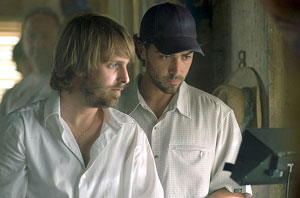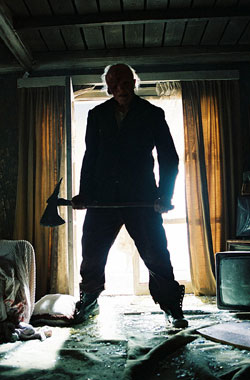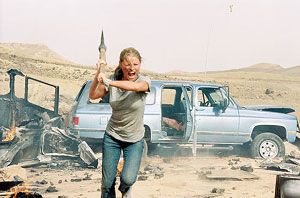 I’m not going to split any hairs here. I think Alexandre Aja
I’m not going to split any hairs here. I think Alexandre Aja
is the next genius in the world of extreme films. He has an astonishing and
beautiful vision for the most depraved and disgusting things shown on screen in
the last few decades. What Aja has been doing with High Tension and now his remake
of The Hills Have Eyes is something new – he’s making reconstructionist horror
films, taking the elements of the truly mean-natured and possibly sociopathic
grindhouse movies of the 70s and mixing them with a completely modern sensibility.
I would go so far to say that his only real peer in this is Tarantino.
The Hills Have Eyes is a fantastic film, and one that may
not get fully appreciated for a couple of years. But here at CHUD we’re at
least a decade ahead of the curve (look at how we told you Running Scared would
be good. The four of you who saw it know we were right), so the greatness of the
film is quite evident to us.
Aja is a great interview, even with that thick accent that
become impossible to understand sometimes on a cell phone’s speakerphone
setting. He’s smart and thoughtful, and most refreshingly, honest. You may be
familiar with some elements of this interview – I ran the stuff about High
Tension last week as a news story. It shows that Aja is the kind of filmmaker I
like, the kind who can look at his own work with a critical eye.
Tomorrow I’ll be bringing you an exclusive interview with
Wes Craven, where we discuss comparing this film to his original, and
Vegas
Q: I know that Wes Craven came to you with the Hills Have Eyes remake, but what was it that you liked about the project?
Aja: After making High Tension
we were trying to find the perfect next project, something that would
allow my partner Greg Levasseur to continue the experiment of High Tension,
to go further in the fear, to go further in the fear process, to find
another way to express the survival aspect. We were looking for stories
and at the same there were screenings in Los Angeles of High Tension for industry people. Wes Craven came to one of the screenings and then asked to meet us. Wes Craven, with the Last House on the Left and The Hills Have Eyes, was a major influence on us and on High Tension.
He asked to meet about another project, which was very different, and
during the meeting he said, ‘You know, I was thinking about also maybe
remaking The Hills Have Eyes. What do you think of that? And also I would like to find a new approach, a new take, something to justify why we’re doing The Hills Have Eyes again today.’ We were thinking about how can we reinvent The Hills Have Eyes?
We were thinking about how can we reinvent The Hills Have Eyes?
We are big fans and we have a lot of fun watching the movie again and
again, so why are we remaking it, and how can we justify the remake of
the movie. We came up with the idea of the nuclear testing background,
and everything came together in a very obvious way, and Wes was very
excited. We realized it was exactly the project we were looking for,
something more on the survival side, we allowed us to take what we did
in High Tension
and go further on the make up and the effects and everything. Most of
it is more of an experience of actors acting. For the family it’s very
interesting because all of them are reacting in a different way, so all
of them are reacting with a different arc.
Q: You definitely took the film farther than High Tension, and I guess the MPAA thought too far – I understand they cut some stuff out.
Aja: They
cut like a little bit less than two minutes. I think most of it is very
naïve from them that they think they can change the intensity of the
movie cutting like a dozen shots here and there. It’s very sad for me
as a filmmaker because I love these shots and we spent time to do it.
Most of them are like gags and very violent and powerful – but not more
violent than the whole of the film as it is now. There is the DVD and
people who want to see a little bit more will be able to see it on DVD.
Q:
Were you concerned that you might lose audiences during the very
intense rape scene, since they aren’t used to seeing something so
brutal in movies anymore?
Aja:
Maybe it’s because I’ve seen so many movies that I’m a little bit
immunized against that kind of thing. I think maybe it’s because of the
way that we shot the scene that people find it so powerful. We were
very more driven by the idea than what we show for real. Many things
are suggested – the rape is suggested, the breast feeding is mostly
there but not like close-up of the tits or anything like that. You
know, when Fox was organizing the test previews the response were great
to the movie, they were cheering, they were jumping on their feet – it
was amazing. But during the attack on the trailer they were silent,
they were almost traumatized. Some people walked out. I can understand
that.
At the same time because it’s very efficient and very strong. It’s a survival movie – Deliverance is very strong the first time you see it, and that scene, talking about the attack
on the trailer, that scene is a key scene because it makes you feel for
the characters, and you really start to be in the movie and not just
watching it in the screening room. Basically the MPAA asked us to recut
that scene, that’s a scene where we lost almost one minute.
Q:
I think that it works because it is horrifying, and it should be
horrifying. And it shows you how dangerous this film is going to be –
you’re not playing it for laughs, you’re playing it for the intensity.
Aja:
You know what I like is that the film is more of an experience than
just a movie. It’s something you’re going to live and not just watch.
It’s what makes them so horrifying is that you’re really in it. The key
to manage to make that kind of film is to make it as realistic as you
can. If you are with a character who is watching something absolutely
horrible, you have to show that. If you want the audience to feel that
and to be inside the mind you have to see what she’s watching.
Q:
You also have some interesting things going on politically. You have
the pacifist Democrat who has to become an action hero, who even uses
an American flag to kill someone. You have all these shots with
swelling music and low, heroic camera angles that recall Western films.
What are you saying with that?
Aja: I
wanted to try to use the imagery of the American flag that you can see
on all the cars after September 11th. To use not the cliché but the way
that the Carter family was acting was exactly the same way they were
acting in the 70s, when we had a similar kind of world. Beyond that I
didn’t want to make a movie where the good guys were only the good guys
and the bad guys were only the bad guys. It was more about the good
guys are also the bad guy in the way that their forefathers did the bad
things in the desert. The bad guys are also victims trying to survive –
all the people living in the hills are not only cannibals and monsters,
they are also the victims of the society that created them and forgot
them in the desert. Beyond that, it’s also interesting to see how
society’s creating it’s own monsters and then one day has to face them.
Q: Whenever High Tension
comes up, people split into two camps, and one of those camps is filled
with people who hated the twist ending. What do you have to say to
those people?
Aja: It’s
kind of funny because the first draft of the script, the script we
wanted to do, had the same twist but just in the final minutes. You
started the movie in the hospital room and she’s telling the story and
then you come back to the hospital room in the end, so you have the
feeling that the killer was the killer, but then the doctor brought a
VCR into the room, watching the security video from the gas station and
you realize she axes the guy. That was the final twist, and the twist
was only saying, ‘OK what you saw was her vision of the story and the
truth is another movie.’
The
producer, unfortunately, asked us to give up the last scene in the last
reel, and I think that’s where everything became more fragile. I
understand the question of the viewers with the twist coming that way,
which is not like the perfect way to bring it. I regret that we didn’t
have the time or the budget to shoot the two different endings and be
able to, at least on the DVD, have the two different endings.
Q: Is Charles Burns’ Black Hole the next project for you?
Aja: Right now we are working on the script.
Q: And that’s Neil Gaiman and Roger Avary.
Aja: Yeah. It won’t be the next project, it will be, I think, the project following that one. Q: What is the next project?
Q: What is the next project?
Aja:
The next project is a supernatural ghost story we are working on right
now. Depending on the casting, in the next couple of weeks we’ll know
if we have the casting or no, and if that’s the case we’re going to
shoot right away, like in the next couple months.
Q: And this is an original or a remake or an adaptation?
Aja: It’s an original film.
Q: With Black Hole,
it seems like the book will be tough to adapt because there are so many
characters and stories involved, and it doesn’t follow a very
conventional narrative structure.
Aja:
We are trying to stay as faithful as possible to the graphic novel,
which I have to say is the best thing I have read since like so long…
It’s just amazing, it’s like someone managed to get a very accurate
picture of what it’s like to be a teenager. We’re going to respect that
spirit and try to make, as the graphic novel is, a very true
description of adolescence and what it is to feel as a monster when you
are 15, 16 years old.
Q:
And you think you’ll be able to have the characters look as ugly as
they do in the comic? One of the things I’m curious about is whether a
studio is going to want to put out a movie where all the leads look
like monsters.
Aja: You
know, I really hope they let us do that. And I think that if we manage
to write a script which is not too expensive, they will let us make the
movie under the radar and make the movie as fucked up as the graphic
novel.